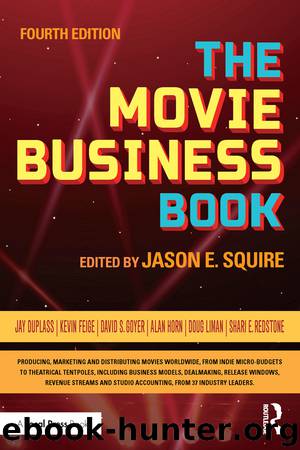The Movie Business Book by Squire Jason E;

Author:Squire, Jason E;
Language: eng
Format: epub
Publisher: Taylor and Francis
We access, view, and experience filmed entertainment in ways unimagined just a few years ago. New companies introduce new digital distribution platforms faster than consumer habits can shift. As a result, motion picture content continues to become more accessible, more mobile, more affordable. The concept of appointment viewing, seeing a film in a certain place, at a certain time, seems antiquated. Today consumers have access to all content, any time, on any device, at low (or no) cost.
But the industry is slow to adapt to the online customer world. This is because most studios are constrained by agreements under the traditional model of “release windows.” Distributors need to wait for existing agreements with traditional media to expire before structuring alternative arrangements.
The term release windows or just “windows” describes the different contractual periods of time during which a film is available to consumers via particular media. For example, the term “free TV window” refers to the contractual time frame when a film is available on broadcast (free) TV. The term holdback refers to those periods when the studio or distributor content owner prohibits exhibition via a particular medium. There also may be multiple windows of availability for the same medium. For example, TV exploitation may be held back for 24 months from initial theatrical release, then have an 18-month window of availability, followed by another holdback period. It can get complicated.
This system of windows and holdbacks protects theatrical exhibitors, the traditional centerpiece of studio film distribution, which have the distinct advantage of being first in the marketplace and benefit from expensive studio marketing campaigns.
In addition, the timed system prevents a film from competing with itself and cannibalizing its own revenues, while generating momentum for the upcoming means of distribution. The windowing calendar must be rigid enough to maintain a roughly level playing field among film distributors, yet flexible enough to garner the maximum revenue from one form of distribution before the next window opens.
This chapter will review the calendar of release windows and revenue streams, the life-cycle of a movie, before going deeper into typical transactions at each step. Along the way, the reader will notice how distributors seek to maximize film revenue by providing as many different opportunities for consumers to access the product, and pay for that access, on multiple occasions over time.
For accounting purposes, revenue streams are often referred to as “waterfalls.” There can be different waterfalls in discussions with participants, studios or individual investors, but in each case it is the point at which the applicable revenue is counted. For example, a distributor’s waterfall might refer to the accumulation of its share from all revenue streams on a specific movie as they flow into the “picture pot” or “studio bucket.”
Some history: The concepts of windows and holdbacks originated in the early 1980s. Until then, a theatrical film would premiere in theaters and run for a typical period of 12 weeks. Some would remain in theaters longer, if unusually strong attendance supported it. After the theatrical run, there would be a blackout period for a year or more, followed by TV exhibition.
Download
This site does not store any files on its server. We only index and link to content provided by other sites. Please contact the content providers to delete copyright contents if any and email us, we'll remove relevant links or contents immediately.
| Coloring Books for Grown-Ups | Humor |
| Movies | Performing Arts |
| Pop Culture | Puzzles & Games |
| Radio | Sheet Music & Scores |
| Television | Trivia & Fun Facts |
The Kite Runner by Khaled Hosseini(4973)
Gerald's Game by Stephen King(4391)
Dialogue by Robert McKee(4184)
The Perils of Being Moderately Famous by Soha Ali Khan(4075)
Story: Substance, Structure, Style and the Principles of Screenwriting by Robert McKee(3337)
The 101 Dalmatians by Dodie Smith(3331)
The Pixar Touch by David A. Price(3231)
Confessions of a Video Vixen by Karrine Steffans(3118)
How Music Works by David Byrne(2976)
Fantastic Beasts: The Crimes of Grindelwald by J. K. Rowling(2860)
Harry Potter 4 - Harry Potter and The Goblet of Fire by J.K.Rowling(2831)
Slugfest by Reed Tucker(2820)
The Mental Game of Writing: How to Overcome Obstacles, Stay Creative and Productive, and Free Your Mind for Success by James Scott Bell(2776)
4 - Harry Potter and the Goblet of Fire by J.K. Rowling(2550)
Screenplay: The Foundations of Screenwriting by Syd Field(2450)
Scandals of Classic Hollywood: Sex, Deviance, and Drama from the Golden Age of American Cinema by Anne Helen Petersen(2409)
Wildflower by Drew Barrymore(2388)
The Complete H. P. Lovecraft Reader by H.P. Lovecraft(2379)
Casting Might-Have-Beens: A Film by Film Directory of Actors Considered for Roles Given to Others by Mell Eila(2312)
